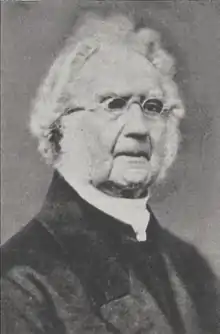Sampson Simson
Sampson Simson (1780 - 7 January 1857) was an Orthodox Jewish[1] American philanthropist most remembered as "the father of Mount Sinai Hospital."[2]

Biography
Simson was born in Danbury, Connecticut to Solomon Simson. Some sources claim that his father was emigrated from Germany[3][4] while others claim that his paternal grandfather was a native New Yorker.[5] The Simson family had moved to Danbury during the American Revolution under the leadership of Gershom Seixas, who felt that Danbury would be a better place to live than Tory-controlled New York City.
Simson studied law under Aaron Burr, attended Columbia University in New York City, and graduated in 1800 with a degree in law[6] and was admitted to the bar in 1802, becoming one of the first Jewish lawyers in New York City.[7]
After a few years practice, however, Simson abandoned his law career and retired to his Yonkers farm to devote himself to charitable work. This was on account of his "distaste for an active public life" as well as an accident that left him disabled for a number of months.[8]
He was described as a very pious man with a "New England conscience", a combination of a "public-spirited citizen" and "conformist Jew". Simson was a member of Congregation Shearith Israel and received great pleasure from his charitable contributions, be they to a Catholic church, a Protestant church or a synagogue. He was also said to be a great admirer of President Andrew Jackson.
From 1825 until 1832, Simson served as the 2nd Grand Commander of the Northern Masonic Jurisdiction of the Scottish Rite of Freemasonry succeeding Daniel D. Tompkins in this position.[9]
In 1852, Simson, along with eight other men representing various Hebrew charitable organizations, came together to establish the Jews' Hospital in New York, the institution that eventually in 1866 became Mount Sinai Hospital. Its location, West 28th Street between 7th and 8th Avenues in New York City, was on land donated by Simson; he served the first president of its board of directors and personally assumed many of the young hospital's financial burdens.[10] The Jews' Hospital opened two years before his death.
That same year, Simson joined Samuel Myer Isaacs and Adolphus Simeon Solomons to help found the Beth Hamedrash Hagodol.[7]
Personal life
Simson never married but was close to his sister, Mrs. Rebecca Isaacks as well as her two children Moses and Jochebed (or Jessie). All three of them had passed away before Sampson Simson.
Legacy
Simson's estate bequeathed large sums of money to Jewish and general institutions, including $50,000 that, after the death of a niece, should be paid "to any responsible corporation in this city whose permanent fund is established by its charter for the purpose of ameliorating the condition of the Jews in Jerusalem, Palestine." In 1888, the New York State Supreme Court decided that the sum, plus 30 years' interest, was to be paid to the North American Relief Society for Indigent Jews in Jerusalem.[11] However, the niece's heir appealed the ruling, and the New York State Court of Appeals overturned it on what would today be considered a technicality (the difference between "charitable" and "benevolent" purposes), awarding the full amount to the heir.[12]
Mount Sinai Hospital was recently ranked as one of the best hospitals in the United States by U.S. News & World Report.[13]
References
- [Publications of the American Jewish Historical Society No. 10 (1902), pp. 109-117 (9 pages) Publications of the American Jewish Historical Society No. 10 (1902)]. The Johns Hopkins University Press. 1902. p. 116.
{{cite book}}: Check|url=value (help) - Mount Sinai Hospital: History Archived 2008-10-09 at the Wayback Machine
- Faber, Eli (1995). The Jewish People in America: A Time for Planting: The First Migration, 1654-1820. Vol. 1 (2005 ed.). Johns Hopkins University Press. p. 66. ISBN 9780801851209.
Encouraged by their integration within a Sephardic-rite community, Ashkenazim readily bequeathed legacies to its synagogue. Hayman Levy, for example, born in Germany, left five pounds to Shearith Israel 'for the benefit of having an Escoba [a memorial prayer] as is usual.' Isaac Adolphus, whose father came from Bonn, bequeathed ten pounds to the synagogue in 1774, while Sampson Simson, whose father also came from Germany, left twenty pounds.
- Deutsche-Amerikanische Historische Gesellschaft von Illinois (1915). Deutsch-amerikanische Geschichtsblätter. Vol. 14. University of Chicago Press. pp. 325–26.
- Isaacs, Myer S. (1902). "SAMPSON SIMSON". Publications of the American Jewish Historical Society (10): 109–117. ISSN 0146-5511. JSTOR 43059667.
- University, Columbia (1876). Catalogue of the Governors, Trustees, and Officers, and of the Alumni and Other Graduates, of Columbia College (originally King's College), in the City of New York, from 1754 to 1876. college.
- This Day in Jewish History
- Isaacs, Myer S. (1902). "SAMPSON SIMSON". Publications of the American Jewish Historical Society (10): 109–117. ISSN 0146-5511. JSTOR 43059667.
- Freemasonry.com
- This House of Noble Deeds, Mount Sinai Hospital, 1852 - 2002, Arthur H. Aufses, Jr. and Barbara J. Niss, New York University Press
- The New York Times, May 30 1888
- Court of Appeals Ruling, June 4, 1889
- U.S. News & World Report: America's Best Hospitals 2007